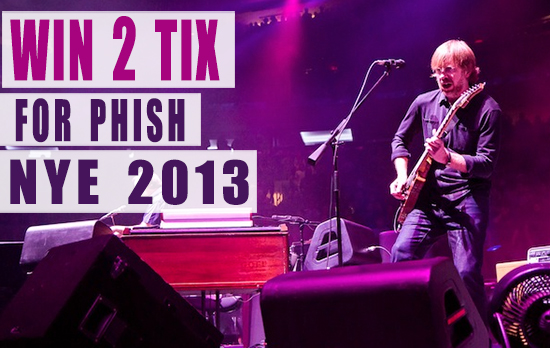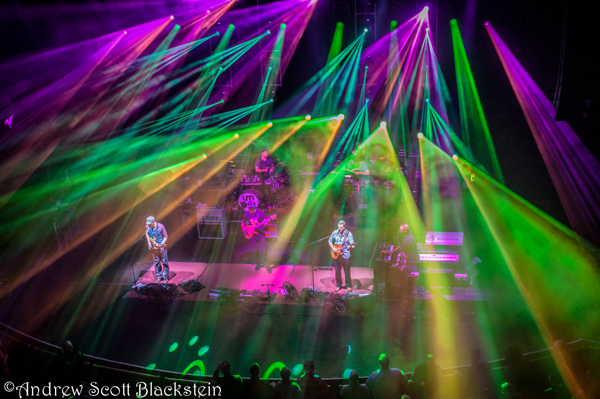The Process of Illumination

Joshua Light show enhances Frank Zappa
It’s midway through the second set at New York’s Beacon Theatre and a complete technical disaster seems imminent. While Umphrey’s McGee plays to a sold- out crowd, the lighting console is on the verge of crashing. Its screens flicker ominously, a tell- tale sign that the board is about to freeze, leaving the lighting designer helpless and literally powerless during one of the year’s most high profile gigs. The timing is a bit unfortunate as all week the Umphrey’s lighting team has been converting the show file to a new, state-of- the-art console, but that is a complex process of ones and zeros and it wasn’t completed in time. So here I am, holding my breath, preparing for the worst as the concert continues with the illusion that the massive light show is running smoothly. But it all hinges on an aging hard drive that continues to glitch and is getting progressively worse as the show surges to its grand finale.
The fact that computers control automated moving lights is a feat itself considering how far lighting design has come in a relatively short amount of time. In the mid-‘60s, promoter Bill Graham started booking Bay Area bands such as the Grateful Dead and Jefferson Airplane at the Fillmore East in New York City, and a team of lighting designers (LDs) began experimenting with the idea that color, movement and texture could complement improvisational music. “Prior to that there was nothing,” says Joshua White, who founded the Joshua Light Show, a team of lighting designers who created “liquid” light shows at the Fillmore. “Anything involving performance or bands—especially for pop culture—before that was filtered by the Ed Sullivans and the Dick Clarks, who really had no imagination.”
Due, in part, to the low balcony at the Fillmore, White’s team used a rear-projection screen and “painted” it with an array of mixed media, which included watercolors, dyes, broken mirrors and slide machines. These primitive, yet extremely psychedelic light shows became an integral part of the concerts and the musicians embraced it. “People were experiencing wonderful things with the sound and now there was something to look it, which was only 50 percent of the experience, but nobody considered that prior,” says White. “The Grateful Dead loved the light show as did other bands from that tradition like The Allman Brothers, and some bands like Pink Floyd recognized on their own that light shows were critical.”
Candace Brightman, who served as the Grateful Dead’s lighting designer, says that one of the most significant developments in concert lighting, for her, came when she changed the vantage point of the light board while working with Traffic. At the time, lighting systems were designed for theater and were controlled from behind the stage. “I brought those dimmers and the controller and moved from backstage into the orchestra pit one day,” she says. “Traffic started throwing chicken bones from the stage and I threw them back. This went on even while they were playing. That band had a great sense of humor.” This is an apt metaphor for the interactive style of lighting that Candace would go on to hone with the Grateful Dead. There was a symbiotic relationship between the musicians and the light show, especially once the technology evolved and the lights began to move.
“By the time the ‘80s arrived, I was really sick of fixed lights,” says Brightman. “Moving lights were great for lighting the audience and band as one, which I had always wanted to do. Such a relief—the endless variety of looks that became available.”
The original concept for the moving light was that it could illuminate multiple positions so if the subject moved, you wouldn’t need as many light sources for even coverage. Most designers, particularly in the theater world, would turn the light off as it was moved from one pre-programmed position to the next. It wasn’t long though before designers such as Brightman started to experiment with leaving the light on while it moved, which was originally discovered by accident.
“At first I thought the Grateful Dead audience would be offended by distracting lighting effects, so I sort of eased into it,” recalls Brightman. “Then, there was an ‘aha’ moment. [Crew chief ] Dan English, who ran the audience lighting, went to move the lights from the stage to another position and accidently opened their shutters as they were headed to a full ceiling [position] during ‘Terrapin Station.’ It happened at a perfect moment: the top of the instrumental after the ‘Terrapin’ refrain. The audience seemed to love it. This was a huge eye-opener for us.”
Indeed, this was a pivotal moment that changed improvisational lighting as we know it today. Over time, Candace continued to develop an emotive style through the use of graceful, deliberate movement and vivid color combinations that would become synonymous with the Dead’s live performances. Many contemporary LDs credit Candace as an influence.
“You didn’t see too many sweeping movements back in the early ‘90s when we started using moving lights,” says Phish lighting designer Chris Kuroda. “But I had seen a lot of Grateful Dead concerts and Candace had done a lot of big, huge audience sweeps so for me it sort of began there.”

Chris Kuroda complements Phish
“To me, that just made my stomach drop a little bit,” says Dave Matthews Band LD Fenton Williams of Brightman’s slow-moving audience lights. “It’s kind of like the moment you go down the big drop on a rollercoaster, seeing them move across the room. The lights would start lower on you, at your knees, and come up to your face and then go over you. And it would be like, ‘Wow, what just happened?’”
Williams was also fascinated by the fast movements that he was discovering with new fixtures. “I don’t ride motorcycles,” he says. “I’m not a real fast person to begin with, but I think it was like this new toy and it was so exciting to take a mirrored light and see how quickly you could take a beam from the stage to the people in the balcony in—bam—just one cue.”
Around the same time that Phish and Dave Matthews Band graduated from theaters to larger venues, both light shows were rapidly growing in size. This was very fortunate timing, as huge advances in moving light technology coincided with both bands’ surges in popularity and arguably helped to fuel it. However, the digital moving light consoles were still very primitive in those days, so Williams was forced to run several at once. “At one point, I may have had six controllers stacked together. I think they could only control up to six lights each. You kind of get used to your timings based on how quickly things can react and how the board is set up.”
Changing light boards was a bit of a challenge as Williams, like many lighting designers, runs his show as if he is “playing” the light board as an instrument. Switching the layout of faders and buttons can affect muscle memory, causing more thought and less creativity. Switching consoles is the equivalent of a piano player performing the same songs with the keys laid out in a different configuration.
Like most art forms, the goal of improv- isational lighting is to get to a mental space where you’re not thinking. This can be difficult when sophisticated technology is at your fingertips. “I find that when I improvise the best, my brain is not even a part of it,” says Kuroda. “[Phish guitarist] Trey Anastasio and I have an expression which comes from the movie The Last Samurai, which is: ‘Too many mind.’ If either of us have a bad set, we’ll meet in the dressing room and go, ‘too many mind.’ Pull your brain out of it and just sort of let it happen without thinking about it too much.
Like Kuroda, Paul Hoffman, Widespread Panic’s LD, played drums at an early age and approaches lighting from a similar frame of mind. “At some point, playing the drum kit becomes less about consciously hitting this cymbal or that drum, but more of a flow and feel of muscle movements, like a dance,” he says. “That’s where I’m trying to get with the console. When the band is playing, I want to disconnect from the programmer in me and become more of a lighting musician.”
Both Hoffman and Williams have embraced technological advances and their shows now include new visual elements such as LED video walls, and in the case
of Williams, automated moving trusses. Kuroda has incorporated the use of pyrotechnics, lasers and video in his recent work with Justin Bieber, but says with Phish, there has been a conscious decision to avoid the extra bells and whistles. “There have been several meetings and discussions over the years about trying to keep it pure with Phish,” he says. “Make it all about the music. Don’t give too much sensory overload. I mean, we do have sensory overload with Phish, but we don’t need extra elements of sensory overload. The way [the band] feels is that you create your own images in your head of what that song represents to you. You don’t need a video image telling you something like, ‘This song equals tree.’”

The author’s work
Back at the Beacon Theatre, the balcony is shaking as fans dance wildly to Umphrey’s McGee’s cover of “Rock The Casbah,” the first song of the encore. The lighting console has still not crashed, although all of the touch screens keep freezing randomly in one-to-two-second increments, an eternity in live music. For the most part, the board is still operational and the lights continue to move. While everyone else in the room seems to enjoy the overwhelming energy of the moment, at the light board, it’s “too many mind.”
Stylistically, the Umphrey’s McGee light show draws from many different influences. Joshua White’s innovative projections are referenced about once a night when the lights create dripping and spinning effects on the backdrop. The deliberate, slow audience sweeps that Candace popularized and Kuroda perfected are incorporated into more regular movements throughout each song, creating constant slow motion. Like Hoffman, there are rhythmic hits accented on the downbeat. And like Williams used to do back in the ‘90s, there are jarring, quick moves from the stage to the audience’s eyes. There is also significantly more haze used in this show, which gives the beams more texture, creating complex geometric shapes and vivid, high-contrast color combinations.
As the second encore draws to a close, the lights stretch to the ceiling and then black out amid a triumphant drum fill. As luck would have it, the light board has managed to limp along through the show’s final note, before promptly crashing 30 seconds later as elated fans file out of the venue while high-fiving a very relieved LD.
It’s just another happy accident in the world of lighting design.



















